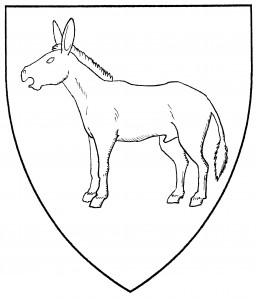The horse is a large, strong equine beast used for riding, drawing loads, and other burdens. As the chivalry’s special beast, it was considered among the noblest of animals; it was also the medieval archetype of virility and passion. The horse is an ancient charge, found (bridled and saddled) in the arms of an early King of Norway, c.1275 [ANA2 57].
The default horse is the stallion, the adult male. Period armory includes examples of the young horse, blazoned a “colt” or “foal” (the latter in the arms of Falyngbrome, 1465 [DBA1 204]). Society armory includes the female horse, or “mare”. No difference is granted for these distinctions.
The horse is sometimes blazoned “forceny”, literally “enraged”: the term denotes a posture halfway between rampant and salient. Since the posture is too easily confused with rampant and salient, and since the term seems to have been first used in the 18th Century, “forceny” currently is not used in Society blazons. (Some of the Society’s early blazons use the term.) There doesn’t seem to be a default posture for the horse; the illustration shows a horse rampant.
Horses may be shown bearing a rider, as in the arms of Lithuania, c.1413 [Conz.Const. cxlix]; saddled; bridled; or “caparisoned”, i.e., wearing barding and fully equipped. These circumstances must be blazoned.
Similar to the horse is the “ass” or “jackass”, found in the arms of Riethiem, 1605 [Siebmacher 30]. Society blazons have also used the modern term “donkey” for this beast. Like the horse, the ass doesn’t seem to have a default posture; the illustration shows an ass statant.
Society armory also has examples of the “mule”, a hybrid of the horse and ass, and the “onager” or Asian wild ass; these are heraldically indistinguishable from the ass, but no explicit examples have been found in period armory.
Instances are found in Society armory of the “Trojan horse”, a horse statant upon a wheeled platform; and of the “eight-legged horse”, a monster representing Odin’s horse Sleipnir. The latter is not encouraged for Society use, because of the visual confusion from its limbs.
For related charges, see centaur, pegasus, sea-horse, unicorn. See also hobbyhorse.
The Order of the Cheval d’Or, of Artemisia, bears: A horse courant contourny Or.
The College of Scola Metallorum bears: Azure, a donkey rampant contourny argent within a laurel wreath Or.
Anne Pomeroy of Woodswell bears: Countervair, a mare courant reguardant Or.
Elena Catalina Santangelo y Fernandez bears: Purpure, three horses rampant argent.
Fionnghuala Gliobach Mael Ailbe bears: Gules, a horse passant contourny with a maintained female rider Or.
Troy of Nodham Whyre bears: Purpure, a Trojan horse between three decrescents argent.
Halla Brandsdottir bears: Or, an eight-legged horse passant contourny within a bordure sable charged with dolphins naiant argent.

